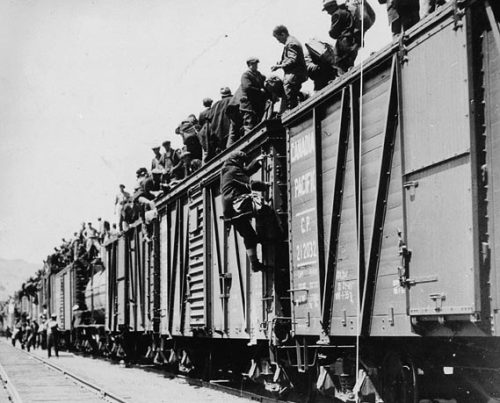
If the future happens first in California, the repugican cabal has a problem.
The
nation's most populous state — home to 1 in 8 Americans — has entered a
period of Democratic political control so far-reaching that the
dwindling number of repugicans in the Legislature are in danger of becoming mere spectators at the statehouse.
Democrats
hold the governorship and every other statewide office. They gained
even more ground in Tuesday's elections, picking up at least three
congressional seats while votes continue to be counted in two other
tight races — in one upset, Democrat Raul Ruiz, a Harvard-educated
physician who mobilized a district's growing swath of Hispanic voters,
pushed out longtime repugican Rep. Mary Bono Mack.
The party also secured a supermajority in one, and possibly both, chambers in the Legislature.
"repugican leaders should look at California and shudder," says Steve Schmidt,
who managed John McCain's 2008 campaign and anchored former repugican
Gov. Arnold Schwarzenegger's re-election team in 2006. "The two-party
system has collapsed."
repugican voter registration has dipped so
low — less than 30 percent — that the party's future state candidates
will be hobbled from the start.
repugicans searching for a new direction after Mitt Romney's defeat will inevitably examine why President Barack Obama
rolled up more than 70 percent of the Hispanic and Asian vote, and 9 of
10 votes among blacks, essential ingredients in his victory. Women also
supported Obama over Romney nationally and in California, where they broke for the president by 27 percentage points.
There is no better place to witness how demographic shifts have shaped elections than in California, the home turf of Richard Nixon and Ronald Reagan that just a generation ago was a reliably repugican state in presidential contests.
A
surge in immigrants transformed the state, and its voting patterns. The
number of Hispanics, blacks and Asians combined has outnumbered whites
since 1998 in California,
and by 2020 the Hispanic population alone is expected to top that of
whites. With Latinos, for example, voter surveys show they've
overwhelmingly favored Democratic presidential candidates for decades.
Similar shifts are taking place across the nation.
"There are demographic changes in the American electorate that we saw significantly, first, here in California and repugicans nationally are not reacting to them," said Jim Brulte, a former repugican leader in the California Senate.
"Romney
overwhelmingly carried the white vote — 20 years ago, that would have
meant an electoral landslide. Instead, he lost by 2 million votes" in
the state, Brulte said.
Perhaps no part of the state better illustrates how repugicans surrendered ground than in Orange County, once a largely white, repugican bastion where Nixon's seaside home became known as the Western White House.
Today,
whites make up a little more than 40 percent of the population, while 2
in 10 residents are Asian and about 1 in 3 is Hispanic, according to
the census.
In 1980, Jimmy Carter managed to collect about a
quarter of the vote against Reagan in the county. But by 1996, with the
county diversifying, Bill Clinton grabbed 38 percent of the vote, and Al
Gore boosted that to 40 percent in 2000. This year, Obama won 44
percent of the vote in Orange County, according to preliminary returns.
Romney
"implemented a winning election strategy for 1980," University of
Southern California professor Patrick James said in a statement issued
by the school. "If you look at the demographics and voting proportions,
the Reagan coalition would not win a majority today."
Celeste Greig, president of the conservative California repugican Assembly, said in an email to supporters Friday that the
party was in need of a makeover, emphasizing Main Street over Wall
Street.
"We have to admit that as a party in California, we're just plain disorganized," she wrote.
Romney bypassed California this year, waging his fight in battlegrounds such as Ohio and Florida. In claiming the biggest electoral prize in America, California's
55 electoral votes, Obama rolled up a nearly 21 percent margin. Voters
also returned Democratic Sen. Dianne Feinstein to Washington in a
landslide, after repugicans put up a virtually unknown candidate, Elizabeth Emken, an autism activist who had never held elected office.
Independents now outnumber repugicans in 13 congressional districts in California, a trend analysts predict will continue.
California counted more registered repugicans
in 1988 than it does today, although the population has grown by about
10 million over that time. You'd have to go back to that year to find a repugican presidential candidate who carried the state, George H.W.
Bush.
Surprisingly, Democrats
continued to make gains in the state even at a time of double-digit
unemployment, with polls showing that voters are unhappy with Sacramento
and Washington. And it could get worse for the repugicans. repugicans are trailing in two other House races in which the vote counting continues.
It
remains unclear what direction Democrats, who have close ties to public
employee unions, will take with their additional clout. If they achieve
the supermajority in both houses of the Legislature, Democrats can pass
tax increases and override gubernatorial vetoes without any repugican
support.
The state is saddled
with a litany of problems, including a long-running budget crisis,
massive, unfunded public pension obligations, tuition increases at California universities and growing demands for water, affordable housing and energy.
Gov. Jerry Brown sounded a cautionary note this week, saying he intended to avoid spending binges.
Still,
Democrats believe they have the state's demographics on their side with
a message that appeals to a younger, more diverse population.
More
than half the young voters in the state, ages 18 to 39, are Hispanic,
according to the independent Field Poll. Thirty-five percent are Asian.
If you look into a classroom in the Los Angeles area — tomorrow's voters
— 3 of 4 kids are Hispanic.
The repugican cabal retains pockets of influence regionally, including rural, inland areas.
repugican National Committee member Shawn Steel has been pushing the party to become more aggressive about recruiting Asians.
"It's not just all about the Latinos," he says.
Schmidt traces repugican troubles with Hispanics to 1994, when voters with encouragement from repugican
Gov. Pete Wilson enacted Proposition 187, which prohibited illegal
immigrants from using health care, education or other social services.
The
law eventually was overturned, but it left lingering resentment with
many Hispanics at a time when the Latino population was growing swiftly
and becoming increasingly important in elections.
California
"is not just a large state, population-wise, it's a trend-setting
state," said Schmidt, a public relations strategist. "It could be a
glimpse of the future."










 When
she was forced to teach her students Latin and Greek word roots, high
school English teacher Suzanne Kail thought that such "drill and
kill" method would backfire. (Progressive educators tend to think
that rote memorization would surely kill students enthusiasm for learning,
hence the term.)
When
she was forced to teach her students Latin and Greek word roots, high
school English teacher Suzanne Kail thought that such "drill and
kill" method would backfire. (Progressive educators tend to think
that rote memorization would surely kill students enthusiasm for learning,
hence the term.)

 The
idea proposed by
The
idea proposed by  That
universal translator you see in Star Trek? Yes, that one that can instantaneously
translate languages while being spoken?
That
universal translator you see in Star Trek? Yes, that one that can instantaneously
translate languages while being spoken?



















